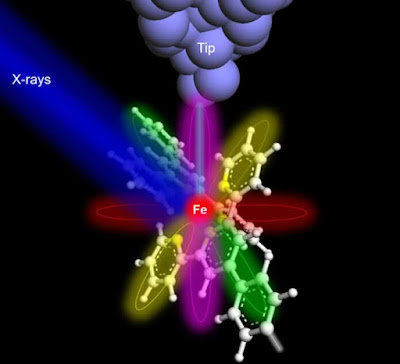{PHOTO} First X-ray of a single atom in nature, ever
Since their discovery, X-rays have been used extensively in a variety of fields
, including materials research, environmental science, and medicine. Reducing the amount of material needed to characterize X-ray is a long-standing objective.The first X-ray SIGNAL (or SIGNATURE) of a single atom has been captured by a team of researchers from Ohio University, Argonne National Laboratory, the University of Illinois at Chicago, and other institutions, under the direction of Saw Wai Hla, professor of physics at Ohio University and scientist at Argonne National Laboratory.
Atoms can be regularly viewed via scanning probe microscopes, but without X-rays, it is hard to know what materials they are made of. It is feasible to determine an atom's exact sort while assessing its chemical state bit by bit.
"Once we can do that, we can trace the materials all the way down to just one atom," Hla said. This will have a significant impact on environmental and medical sciences, and perhaps even lead to the discovery of a cure that could have a profound effect on humanity. This discovery will alter the course of history.
At the XTIP beamline of the Advanced Photon Source and the Center for Nanoscale Materials at Argonne National Laboratory, researchers employed a specially designed synchrotron X-ray equipment.
The group gave the examples of an iron atom and a terbium atom in their respective molecular hosts. The research team employed a method known as synchrotron X-ray scanning tunneling microscopy, or SX-STM, which entails positioning a unique detector made of a pointed metal tip close to the sample to gather excited X-ray electrons in addition to conventional X-ray detectors to detect the signal of a single atom. In SX-STM, X-ray spectroscopy is started by the photoabsorption of core-level electrons, which generates elemental fingerprints and effectively detects the elemental type of the materials.
Hla said, “The spectrums are like fingerprints, each unique and able to detect exactly what it is.”
Tolulope Michael Ajayi, the first author of the paper and doing this work as part of his Ph.D. thesis, said, “The technique used, and concept proven in this study, broke new ground in X-ray science and nanoscale studies. More so, using X-rays to detect and characterize individual atoms could revolutionize research and give birth to new technologies in areas such as quantum information and the detection of trace elements in environmental and medical research, to name a few. This achievement also opens the road for advanced materials science instrumentation.”
"We have also found the chemical states of individual atoms," Hla said. We discover that the terbium atom, a rare-earth metal, is isolated and does not change its chemical state by contrasting the chemical states of an iron atom and a terbium atom inside respective molecular hosts. The iron atom, however, has a powerful interaction with its environment.
With this discovery, scientists are now able to identify an element's type as well as its chemical state, giving them the ability to better control the atoms inside different material hosts to meet the always changing needs in many fields. They have also developed a novel method called "X-ray excited resonance tunneling, or X-ERT," which enables researchers to use synchrotron X-rays to discover how an individual molecule's orbitals are structured.
According to Hla, "This achievement connects synchrotron X-rays with the quantum tunneling process to detect the X-ray signature of an individual atom and opens many exciting research directions, including the research on the quantum and spin (magnetic) properties of just one atom using synchrotron X-rays."




Comments
Post a Comment